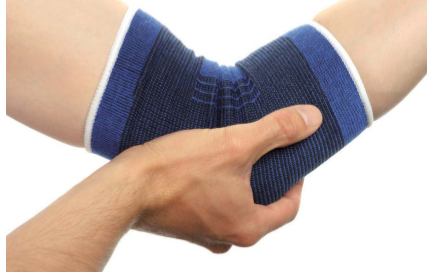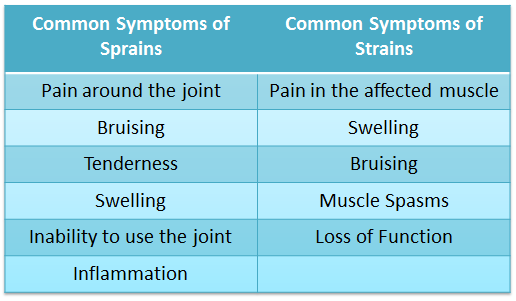
Sprains and strains affect the muscles and ligaments which help to keep the bones together and stable. Ligaments are strong bands of tissue that surround the joints and connect bones together.
Sprains occur when ligaments are stretched, twisted or torn as a result of excessive force being applied to a joint. The most common areas affected are the knee, wrist and ankle.
Strains occur when muscle fibres are stretched or torn. This type of injury often occurs due to accidents or as a result of an injury during physical activity. The most common areas affected are hamstring, quadriceps and lumbar.
It is hard to estimate how common sprains and strains are as most people do not report the injury. However an estimated 1-1.5 million visits to accident and emergency are due to an ankle sprain.
Symptoms of Sprains and Strains

Customers presenting with the following symptoms should be referred to the pharmacist:
- Severe pain.
- Affected joint cannot bear any weight.
- Affected joint does not move freely.
- Numbness in the affected area.
- The affected area does not respond to treatment (see treatment section).
- Haematoma which looks like a dark red bruise and occurs when blood collects under the skin
Causes of Sprains and Strains
- Over stretch
- Make a sudden change of direction
- Make a change of speed
- Fall or land awkwardly
- Have a collision with an object
- Receive a blow to a joint
The most common cause of sprains and strains is participation in sport or physical activity.
Preventing Strains and Sprains
There are a number of tips you can provide to customers to help them prevent injuries:
- Wear the correct footwear for the activity you are doing, for example, specifically designed running shoes when jogging.
- Take part in regular exercise particularly strengthening and stretching as this will help to keep your joints flexible and reduce the likelihood of injury.
- Warm up and cool down the muscles when taking part in exercise.
- Avoid exercising when fatigued as this can increase the risk of injury.
Treatment for Sprains and Strains
Most sprains and strains can be treated at home by using the following techniques:
RICE Therapy
- Rest – the affected joints or muscles should be completely rested (where practical) for the ï¬rst 48 to 72 hours after injury.
- Ice – apply ice to the area for 15 to 20 minutes every two to three hours and continue this for the ï¬rst 48 to 72 hours. Ensure that the ice is wrapped in a damp towel and is not applied directly to the skin and do not leave the ice on overnight.
- Compression – apply a compression bandage to limit the swelling and movement. Ensure that the bandage is comfortable and not restricting circulation and remove it before going to sleep.
- Elevation – raise the injured area and support it with a pillow to help reduce the swelling.
Avoiding HARM
- Heat – hot baths, saunas and heat packs, sprays or rubs, should only be applied 48 hours after sustaining an injury as it can increase blood flow leading to increased inflammation.
- Alcohol – increases bleeding and swelling and can delay the healing process.
- Running – avoid any form of exercise that can cause further damage.
- Massage – in the first 48 hours after injury may increase bleeding and swelling.
The guidelines on immobilising sprains and strains are different. Sprains should not be immobilised and a customer should be encouraged to start to move the joint through gentle exercise e.g. rotation of the ankle as soon as they feel able as this will aid the healing process. However, there is an exception, severe ankle injuries should be immobilised for the first ten days as normal function is resumed quicker.
It is recommended that strained muscles should be immobilised for the first few days, the length of time will depend on the severity of the injury. Immobilisation helps the healing process and allows movement without tearing or pulling to occur in the same place.
Compression is recommended to limit swelling and reduce movement to mitigate the risk of further injury. This can be done by using a crepe bandage, elastic bandages or elasticated tubular bandages.
To reduce any swelling or inflammation it is recommended to use NSAIDs such as ibuprofen or diclofenac. NSAIDs are available in oral and topical formats which can be used to treat muscular pain. Always advise customers to read the manufacturer’s instruction for application.
It is important to advise customers that painkillers can mask an injury so while they may not be feeling any pain it does not mean the injury has healed. They need to ensure that the injury is fully rested and supported properly to prevent any further injury and aid recovery. Also if a customer takes a painkiller and continues to exercise then they may not realise that their injury has deteriorated. There is also the added risk that a customer may overuse painkillers to manage their pain. Over-use of painkillers can lead to further problems such as chronic headache.
Oral and topical NSAIDs can sometimes be used in combination but any customer wishing to use both formats at the same time must be referred to the pharmacist. Side effects can still occur when using a topical NSAID so they should not be recommended to the following patient groups (unless prescribed):
- Pregnant or breast feeding women.
- Asthmatics that have experienced previous side effects or people with severe allergic reactions.
- Customers who suffer from indigestion, heartburn or stomach ulcers.
- Anyone with heart or kidney disorders.
